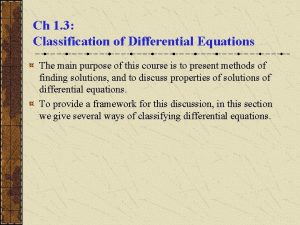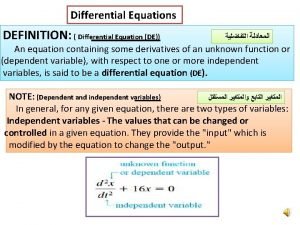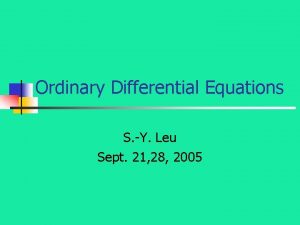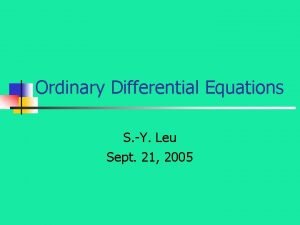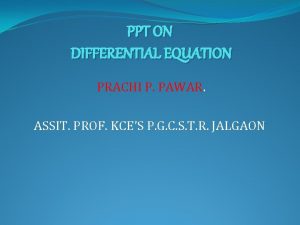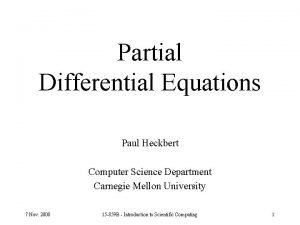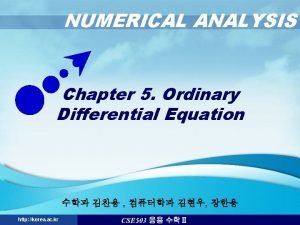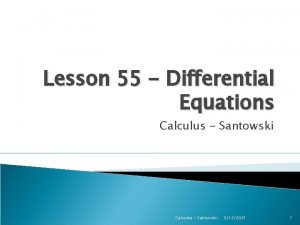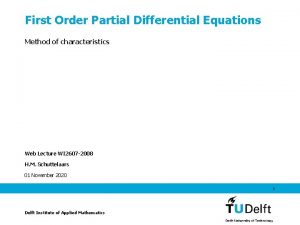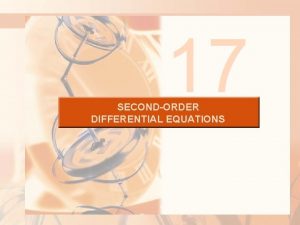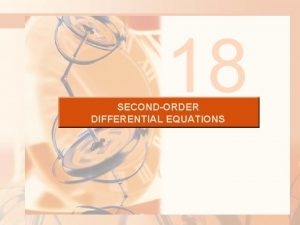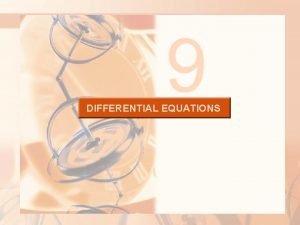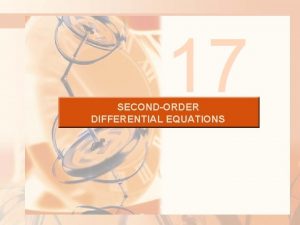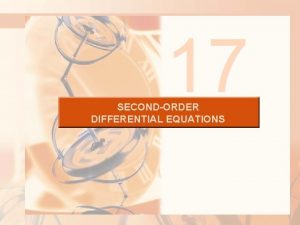7 6 Differential Equations Differential Equations Definition A













- Slides: 13

7. 6 Differential Equations

Differential Equations Definition A differential equation is an equation involving derivatives of an unknown function and possibly the function itself as well as the independent variable. Example 1 st order equations 2 nd order equation The order of a differential equation is the highest order of the derivatives of the unknown function appearing in the equation In the simplest cases, equations may be solved by direct integration. Definition Examples Observe that the set of solutions to the above 1 st order equation has 1 parameter, while the solutions to the above 2 nd order equation depend on two parameters.

Separable Differential Equations A separable differential equation can be expressed as the product of a function of x and a function of y. Example: Multiply both sides by dx and divide both sides by y 2 to separate the variables. (Assume y 2 is never zero. )

Separable Differential Equations A separable differential equation can be expressed as the product of a function of x and a function of y. Example: Combined constants of integration

Family of solutions (general solution) of a differential equation Example The picture on the right shows some solutions to the above differential equation. The straight lines y = x and y = -x are special solutions. A unique solution curve goes through any point of the plane different from the origin. The special solutions y = x and y = -x go both through the origin.

Initial conditions • In many physical problems we need to find the particular solution that satisfies a condition of the form y(x 0)=y 0. This is called an initial condition, and the problem of finding a solution of the differential equation that satisfies the initial condition is called an initial-value problem. • Example (cont. ): Find a solution to y 2 = x 2 + C satisfying the initial condition y(0) = 2. 22 = 02 + C C=4 y 2 = x 2 + 4

Example: Separable differential equation Combined constants of integration

Example (cont. ): We now have y as an implicit function of x. We can find y as an explicit function of x by taking the tangent of both sides.

Law of natural growth or decay A population of living creatures normally increases at a rate that is proportional to the current level of the population. Other things that increase or decrease at a rate proportional to the amount present include radioactive material and money in an interest-bearing account. If the rate of change is proportional to the amount present, the change can be modeled by:

Rate of change is proportional to the amount present. Divide both sides by y. Integrate both sides. Exponentiate both sides.

Logistic Growth Model Real-life populations do not increase forever. There is some limiting factor such as food or living space. There is a maximum population, or carrying capacity, M. A more realistic model is the logistic growth model where growth rate is proportional to both the size of the population (y) and the amount by which y falls short of the maximal size (M-y). Then we have the equation: The solution to this differential equation (derived in the textbook):

Mixing Problems A tank contains 1000 L of brine with 15 kg of dissolved salt. Pure water enters the tank at a rate of 10 L/min. The solution is kept thoroughly mixed and drains from the tank at the same rate. How much salt is in the tank (a) after t minutes; (b) after 20 minutes? This problem can be solved by modeling it as a differential equation. (the solution on the board)

Mixing Problems Problem 45. A vat with 500 gallons of beer contains 4% alcohol (by volume). Beer with 6% alcohol is pumped into the vat at a rate of 5 gal/min and the mixture is pumped out at the same rate. What is the percentage of alcohol after an hour?
 Classification of differential equations
Classification of differential equations Definition of differential equation
Definition of differential equation Ordinary differential equations example
Ordinary differential equations example Non linear ode
Non linear ode Differential equations examples
Differential equations examples Euler's differential equation
Euler's differential equation Differential equations projects
Differential equations projects Formation of partial differential equations ppt
Formation of partial differential equations ppt Differential equations in computer science
Differential equations in computer science Cengage differential equations
Cengage differential equations Adam moulton method
Adam moulton method Differential equations calculus
Differential equations calculus Seperation of variables
Seperation of variables Partial differential equations examples
Partial differential equations examples
